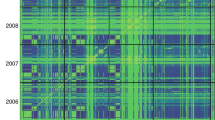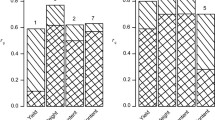Abstract
Genomic selection studies usually use few environmental models to predict progenies from biparental crosses. However, in a maize breeding program, numerous crosses need to be evaluated in multiple field trials to identify single-crosses with greater yield potential. In this study, 614 AFLP marker effects estimated in 250 maize single-crosses evaluated in 13 environments were used to assess the influence of training population size (N), number of markers (NM), genotype-by-environment interaction (G × E) and population structure on the prediction accuracy (rMG) for grain yield using RR-BLUP model. Cross validation analysis were performed within and across environments, and within and across groups of related single-crosses. Then, genomic selection was compared to phenotypic selection in identifying the best single-crosses in a maize breeding program scheme. In general, increasing the training population size and the number of markers did not led to higher accuracy estimates. Predicted accuracies from cross validation analysis within environments were significantly higher than between environments, indicating that the effect of G × E interaction was important. Accuracy estimates were also higher when training and validation sets were composed of related single-crosses. In all scenarios, wide intervals of accuracy were found, meaning that genomic prediction may not be effective depending on the single-crosses sampled. The use of genomic prediction in maize breeding programs was discussed emphasizing the need of a training set evaluated in multiple environments and designing a genomic selection experiment according to the population structure so as to reduce sample problems and maximize the accuracy and the success of prediction.
Similar content being viewed by others
References
Albrecht T, Wimmer V, Auinger HJ, Erbe M, Knaak C, Ouzunova M, Simianer H, Schon CC (2011) Genome-based prediction of testcross values in maize. Theor Appl Genet 123:339–350
Albrecht T, Auinger HJ, Wimmer V, Ogutu JO, Knaak C, Ouzunova M, Piepho HP, Schon CC (2014) Genome-based prediction of maize hybrid performance across genetic groups, testers, locations and years. Theor Appl Genet 127:1375–1386
Alves GF (2006) Relações entre seleção de testadores de milho e suas divergências genéticas. Theses, Escola Superior de Agricultura Luiz de Queiroz, Universidade de São Paulo
Bernardo R (2010) Breeding for quantitative traits in plants. Stemma Press, Woodbury
Bernardo R, Yu J (2007) Prospects for genome wide selection for quantitative traits in maize. Crop Sci 47:1082–1090
Bonin A, Bellemain E, Bronken Eidesen P, Pompanon F, Brochmann C, Taberlet P (2004) How to track and assess genotyping errors in population genetics studies. Mol Ecol 13:3261–3273
Combs E, Bernardo R (2013) Accuracy of genomewide selection for different traits with constant population size, heritability, and number of markers. Plant Genome 6:1–7
Crossa J, de los Campos G, Perez P, Gianola D, Atlin G, Burgueño J, Araus JL, Makumbi D, Yan J, Arief V, Banziger M, Braun HJ (2010) Prediction of genetic values of quantitative traits in plant breeding using pedigree and molecular markers. Genetics 186:713–724
Crossa J, Pérez P, Hickey J, Burgueño J, Ornella L, Cerón-Rojas J, Zhang X, Dreisigacker S, Babu R, Li Y, Bonnett D, Mathews K (2014) Genomic prediction in CIMMYT maize and wheat breeding programs. Heredity 112:48–60
Dekkers JCM (2007) Prediction of response to marker-assisted and genomic selection using selection index theory. J Anim Breed Genet 124:331–341
Development Core Team R (2012) R: A language and environment for statistical computing. R Foundation for Statistical Computing, Vienna
Endelman JB (2011) Ridge regression and other kernels for genomic selection with R package rrBLUP. The Plant Genome 4:250–255
Falconer DS, Mackay TFC (1996) Introduction to quantitative genetics. Longmans Green, Harlow
Goddard ME, Hayes BJ (2007) Genomic selection. J Anim Breed Genet 124:323–330
Hallauer AR, Carena MJ, Miranda Filho JB (2010) Quantitative genetics in maize breeding. Springer, New York
Hansen M, Kraft T, Christiansson M, Nilsson NO (1999) Evaluation of AFLP in Beta. Theor Appl Genet 98:845–852
Hayes BJ, Cogan NOI, Pembleton LW, Goddard ME, Wang J, Spangenberg GC, Foster JW (2013) Prospects for genomic selection in forage plant species. Plant Breed 132:133–143
Heffner EL, Sorrells ME, Jannink JL (2009) Genomic selection for crop improvement. Crop Sci 49:1–12
Heffner EL, Lorenz AJ, Jannink JL, Sorrells ME (2010) Plant breeding with genomic selection: gain per unit time and cost. Crop Sci 50:1681–1690
Henderson CR (1984) Applications of linear models in animal breeding. University of Guelph, Guelph
Hickey MJ, Dreisigacker S, Crossa J, Hearne S, Babu R, Prasanna BM, Grondona M, Zambelli A, Windhausen VS, Mathews K, Gorjanc G (2014) Evaluation of genomic selection training population designs and genotyping strategies in plant breeding programs using simulation. Crop Sci 54:1476–1488
Jacobson A, Lian L, Zhong S, Bernardo R (2014) General combining ability model for genomewide selection in a biparental cross. Crop Sci 54:895–905
Li JZ, Zhang ZW, Li YL, Wang QL, Zhou YG (2011) QTL consistency and meta-analysis for grain yield components in three generations in maize. Theor Appl Genet 122:771–782
Lian L, Jacobson A, Zhong S, Bernardo R (2014) Genomewide prediction accuracy within 969 maize biparental populations. Crop Sci 54:1514–1522
Lorenzana RE, Bernardo R (2009) Accuracy of genotypic value predictions for marker- based selection in biparental plant populations. Theor Appl Genet 120:151–161
Massman JM, Gordillo A, Lorenzana RE, Bernardo R (2013) Genomewide predictions from maize single-cross data. Theor Appl Genet 126:13–22
Meudt HM, Clarke AC (2007) Almost forgotten or latest practice? AFLP applications, analyses and advances. Trends Plant Sci 12:106–117
Meuwissen THE, Hayes BJ, Goddard ME (2001) Prediction of total genetic value using genome-wide dense marker maps. Genetics 157:1819–1829
Mueller UG, Wolfenbarger LL (1999) AFLP genotyping and fingerprinting. Trends Ecol Evol 14:389–394
Pompanon F, Bonin A, Bellemain E, Taberlet P (2005) Genotyping errors: causes, consequences and solutions. Nat Rev Genet 6:847–859
SAS Institute (2008) Statistical analysis software. Cary, NC, United States
Schulz-Streeck T, Ogutu JO, Karaman Z, Knaak C, Piepho HP (2012) Genomic selection using multiple populations. Crop Sci 52:2453–2461
Schulz-Streeck T, Ogutu JO, Gordillo A, Karaman Z, Knaak C, Piepho HP (2013) Genomic selection allowing for marker-by-environment interaction. Plant Breed 132:532–538
Shirasawa K, Kishitani S, Nishio T (2004) Conversion of AFLP markers to sequence-specific markers for closely relate lines in rice by use of the rice genome sequence. Mol Breed 14:283–292
Singh BD, Singh AK (2015) Marker-assisted plant breeding: principles and practices. Springer, New Delhi
Smith AB, Cullis BR, Thompson R (2005) The analysis of crop cultivar breeding and evaluation trials: an overview of current mixed model approaches. J Agric Sci 143:449–462
Veldboom LR, Lee M (1994) Molecular-marker facilited studies of morphological traits in maize. II: determination of QTL for grain yield and yield components. Theor Appl Genet 89:451–458
Vignal A, Milan D, SanCristobal M, Eggen A (2002) A review on SNP and other types of molecular markers and their use in animal genetics. Genet Select Evol 34:275–305
Vos P, Rogers R, Bleeker M, Reijans M, Van de Lee T, Hornes M, Fritjers A, Pot J, Peleman J, Kuipe M, Zabeau M (1995) AFLP: a new technic for DNA fingerprint. Nucleic Acids Res 23:4407–4414
Windhausen VS, Atlin GN, Hickey JM, Crossa J, Jannink JL, Sorrells ME, Raman B, Cairns JE, Tarekegne A, Semagn K, Beyene Y, Grudloyma P, Technow F, Riedelsheimer C, Melchinger AE (2012) Effectiveness of genomic prediction of maize hybrid performance in different breeding populations and environments. Genes Genomes Genetics 2:1427–1436
Wolf DP, Peternelli LA, Hallauer AR (2000) Estimates of genetic variance in an F2 maize population. J Hered 91:384–391
Acknowledgments
This research was supported by the Brazilian “Conselho Nacional de Desenvolvimento Científico e Tecnológico” (CNPq—308499/2006-9 and CNPq—301717/2009-5), and by the Department of Genetics at the Agriculture College “Luiz de Queiroz”—University of São Paulo. C. L. Souza Jr. And M. P. Mendes are recipient of a research fellowship from CNPq. The authors are grateful to Dr. Anete Pereira de Souza, from the University of Campinas, for mapping the population; and to A. J. Desidério, C. R. Segatelli and A. Silva for their assistance in the field experiments. We also thank the two anonymous reviewers for their valuable contributions to improve this paper.
Author information
Authors and Affiliations
Corresponding author
Rights and permissions
About this article
Cite this article
Mendes, M.P., de Souza, C.L. Genomewide prediction of tropical maize single-crosses. Euphytica 209, 651–663 (2016). https://doi.org/10.1007/s10681-016-1642-1
Received:
Accepted:
Published:
Issue Date:
DOI: https://doi.org/10.1007/s10681-016-1642-1




